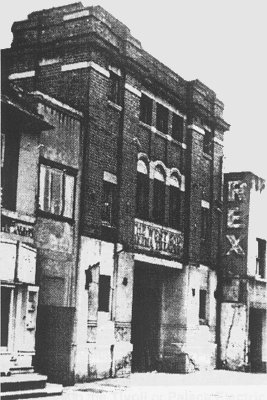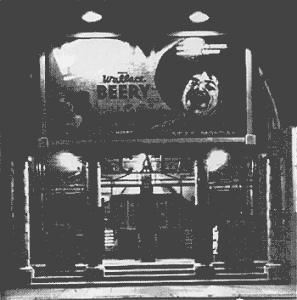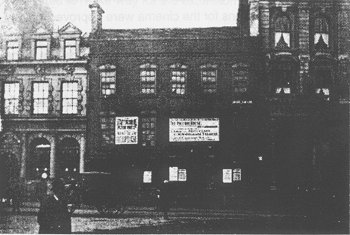






 |
 |
The new cinema had a set of double
swinging doors, a canopy over the entrance and a set of steps up to the
entrance. The seating capacity had been increased to 750 and the new
cinema also had a balcony, broad staircases and a lounge. It was
probably the most outstanding of the town's cinemas at that time.
The West End (Rex) Cinema at the end of its film
life. |
Yet another of Thomas Jackson's cinemas was the Coliseum on
Dudley Road (on the junction of Pearson Street with Dudley Road). The
cinema opened on November 14th 1912 with a similar range of entrance
prices to the Strand (from 2d. to 6d.). The original building had one
storey with a narrow entrance which was set back from the main road.
During 1913 a number of extensions and changes were made, including a
much larger and more impressive frontage, a small balcony and a pitched
roof. A canopy was added later. Like the Picture House, the Coliseum was
sold to the Midland Counties Circuit Ltd. as part of the general
financial re-arrangements made after Thomas Jackson's bankruptcy. In
1930 the Coliseum was acquired by the Quigley family, the owners
of the Olympia. The
largest of the earliest cinemas in Wolverhampton was the
Picturedrome which was located at the end of Worcester Street. The
plans for the cinema were approved in July 1913 and involved a very
elaborate facade with domes, arches and pillars. The auditorium was
planned to accommodate over 900 patrons downstairs and over 200 upstairs
in the balcony.
| The Picturedrome opened in December
1913 but was not very successful in its earliest years. After the
First World War it was renamed the Scala. The new cinema had a
better management team and showed a wider range of programmes and
became relatively successful. However, in 1920, it was sold to
Midlands Entertainments Ltd. The new owners failed to make a
success of the cinema and in 1925 it was sold to Associated
Provincial Picture Houses. On September 28th 1925 a completely
refurbished cinema opened with the programme of 'Winning
Through' and 'The Mirage'. |

The Scala cinema. |

Site of the Queen's Picture House c. early 1914. |
The Queen's further enhanced its growing
reputation as the respectable people's cinema by employing the
town's first uniformed commissionaire, page boys and usherettes. It
had an orchestra led by a very respected musician named
Alfred Van Dam. By the early 1920's the Queen's had
established itself as the town's leading cinema. |
 |
|
 |
Next
Page |
|
Contents |
|
|







 |

















